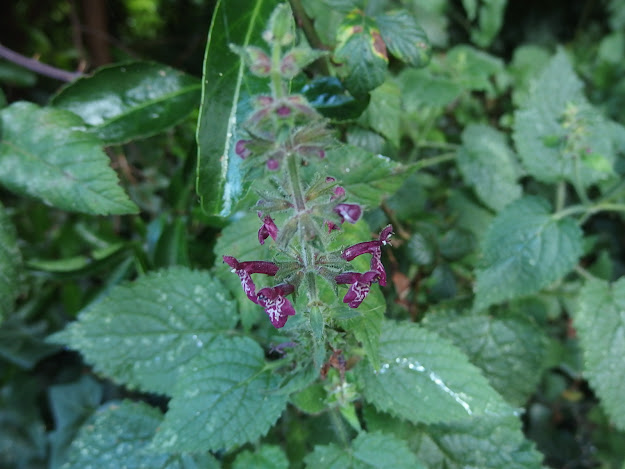Wildflower Wednesday: Hedge woundwort
There my identification would have stayed; thank goodness for blogging and Wildflower Wednesday to encourage me to investigate further! A quick glance at Plantlife's information on the red dead-nettle and I could see straight away my initial ID was wrong owing to the rounder leaves and rather pink flowers. It doesn't have the distinctive markings of my garden's plant.
I turned to my trusty Francis Rose and found the answer within a couple of minutes in the form of exhibit A on the page. The leaves and distinctive flowers mark it out as hedge woundwort (Stachys sylvatica) instead. To be honest I'm a little disappointed it's not the dead-nettle of my initial ID as this is noted as such a good plant for bees, but at least woundwort still has some value for them. Its common name hints at its medicinal value; it's been used for centuries to staunch blood flow and heal wounds. Thank goodness I've not had to use it for this purpose, as the leaves smell quite unpleasant when crushed.
I have no idea where it came from but seeing it's a prolific seedmaker I'm sure the local birds had a role to play in its arrival. It also spreads by rhizomes, so it'll be interesting to see how it fares in the crowded space it now calls home.
Wildflower Wednesday is hosted by Gail at Clay and Limestone.
You may also like:
Seeing it's such a good year for wildflowers, here are my other posts from earlier this year.
- Loving my lawn - the glorious appearance of self-heal in the back garden (hmm, self-heal and woundwort; is my garden trying to tell me something?)
- That blue flower: a spring spotter's guide - the key differences of several wildflowers from the borage family
- A new wildflower on the block - my first new find this year: white violas
Look out next month for another new wildflower from my garden which I found only this morning: fox and cubs. I'm also planning a wildflower ID quiz later this year, as part of my Puzzle Corner strand. I have so many other wildflower finds from my daily walks under lockdown which I haven't told you about!
Latin without tears
Woundwort's latin name is totally appropriate for my acquaintance with it. Stachys means 'spike of flowers' and sylvatica means 'of the forest'. It's planted itself at the edge of the woodland area of my side garden, where there's just enough light for me to spot those distinctive white markings on each beetroot red bloom.












It's fun to find beneficial newcomers to the garden. Well done on the plant ID! Happy WW!
ReplyDeleteThere's quite a few this year Karin, it's an amazing year for wildflowers :)
DeleteYes Michelle, 2020 seems to be that everyone is noticing wildflowers too which is great. They were the first flowers I tried to ID as a girl (with my little Observer's Book of Wild Flowers). I loved to see them on my walks along riverbanks and in woodlands. I don't remember this one but introduced Foxs & Cubs into my borders a few years ago. It gets to stay a while until it takes over then its pulled up (it will return again). I've a few wildflowers throughout my borders. It's hard to pick favourites. Happy WW :-)
ReplyDeleteIt was too urban for many wildflowers where I grew up Shirley, so I'm a late developer! I love my Francis Rose - I had a lovely summer wandering the banks of the Thames and the SSSI where I worked at the Water Research Centre in Medmenham using it to identify all the wildflowers there in my lunch hours :)
DeletePretty little flowers with an intense colour
ReplyDeleteBeetroot red is exactly the right description for them Diana!
DeleteI too have Hedge Woundwort in my borders and wild areas which I pull whenever I spot it as I hate the smell and I won't ever eliminate it because it belongs here but I also have the much nicer Marsh Woundwort with taller, square stems, hardly any smell to the leaves and as its name suggests likes moister ground. It is a prolific spreader by those underground roots. I don't think I can post a picture in these comments but here's a link to my garden club's Facebook page. https://www.facebook.com/groups/941953155968139/
ReplyDeleteLuckily my example is in the ground bordering some public land which is a bit wilder than the rest of my garden, so I can let it be. It's a dry bank, so unsuitable for Marsh Woundwort.
Delete